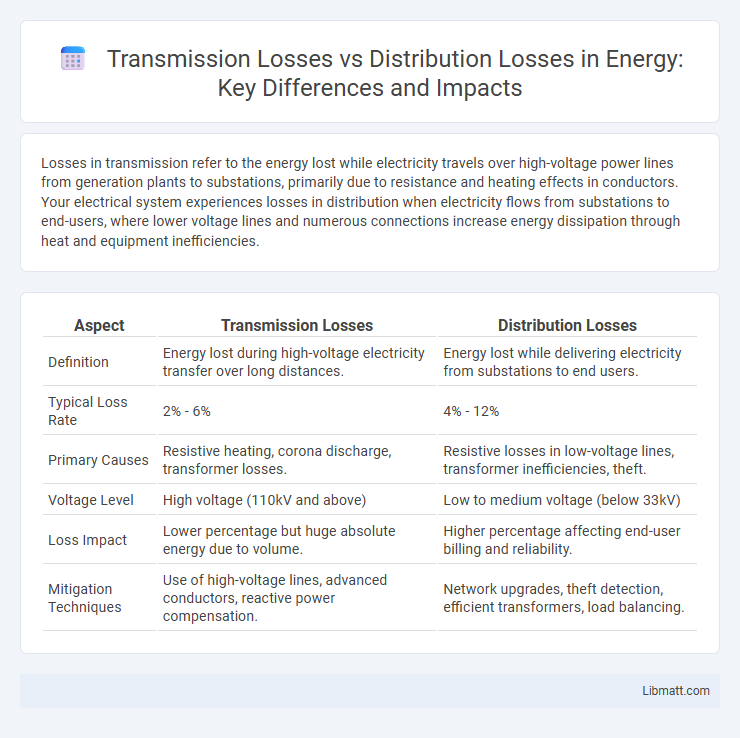Losses in transmission refer to the energy lost while electricity travels over high-voltage power lines from generation plants to substations, primarily due to resistance and heating effects in conductors. Your electrical system experiences losses in distribution when electricity flows from substations to end-users, where lower voltage lines and numerous connections increase energy dissipation through heat and equipment inefficiencies.
Table of Comparison
| Aspect | Transmission Losses | Distribution Losses |
|---|---|---|
| Definition | Energy lost during high-voltage electricity transfer over long distances. | Energy lost while delivering electricity from substations to end users. |
| Typical Loss Rate | 2% - 6% | 4% - 12% |
| Primary Causes | Resistive heating, corona discharge, transformer losses. | Resistive losses in low-voltage lines, transformer inefficiencies, theft. |
| Voltage Level | High voltage (110kV and above) | Low to medium voltage (below 33kV) |
| Loss Impact | Lower percentage but huge absolute energy due to volume. | Higher percentage affecting end-user billing and reliability. |
| Mitigation Techniques | Use of high-voltage lines, advanced conductors, reactive power compensation. | Network upgrades, theft detection, efficient transformers, load balancing. |
Introduction to Electrical Power Losses
Electrical power losses occur during both transmission and distribution, primarily due to resistance in conductors causing heat dissipation. Transmission losses, typically ranging from 2% to 6%, happen over high-voltage lines spanning long distances, while distribution losses, which can be higher at 5% to 15%, occur in lower voltage networks closer to end consumers. Efficient design, advanced materials, and regular maintenance are critical to minimizing these losses and improving overall power system performance.
Overview: Transmission vs Distribution Systems
Transmission losses primarily occur due to high voltage power flow over long distances and are mainly caused by resistive heating in conductors and corona discharge. Distribution losses happen closer to end-users and involve energy dissipation in transformers, distribution lines, and end-use equipment due to lower voltages and more complex network configurations. Understanding these differences helps you optimize energy efficiency and reduce operational costs in power delivery systems.
Types of Losses: Technical and Non-Technical
Losses in transmission primarily involve technical losses such as energy dissipation due to resistance in high-voltage lines and equipment like transformers, while non-technical losses are generally minimal at this stage. In contrast, distribution losses include both significant technical losses from lower voltage conductors and transformers, and higher non-technical losses caused by theft, metering inaccuracies, and unauthorized consumption. Understanding the distinction helps you target loss reduction strategies efficiently to improve overall energy system performance.
Causes of Transmission Losses
Transmission losses mainly result from electrical resistance in high-voltage transmission lines causing heat dissipation, as well as from corona discharge around conductors at very high voltages. Other causes include line faults, improper maintenance, and suboptimal line design that leads to reactive power losses and voltage drops. These losses are typically lower in percentage compared to distribution losses but have a significant impact due to the vast distances covered in transmission networks.
Causes of Distribution Losses
Losses in transmission primarily result from high-voltage line resistance and electromagnetic interference, while losses in distribution are caused by factors such as technical issues, theft, and faulty metering. In distribution, you often encounter issues like conductor deterioration, transformer inefficiencies, and unauthorized connections, leading to significant energy dissipation. Managing distribution losses requires targeted maintenance, upgraded infrastructure, and effective monitoring systems to reduce technical and non-technical losses.
Quantifying Losses: Key Metrics and Formulas
Losses in transmission are typically quantified using the formula P_loss = I2R, where I is the current and R is the resistance of transmission lines, highlighting energy lost as heat over long distances. Distribution losses are measured by comparing the total energy supplied to the distribution network with the energy actually delivered to end consumers, often expressed as a percentage of total input energy. Your ability to reduce these losses depends on accurately monitoring these key metrics to optimize grid efficiency and reliability.
Impact of Losses on Energy Efficiency
Losses in transmission primarily result from high-voltage power lines carrying electricity over long distances, causing resistive heating that decreases overall energy efficiency. Distribution losses occur closer to end-users through lower voltage lines, transformers, and equipment, significantly impacting your energy consumption and costs. Reducing both transmission and distribution losses is vital for maximizing energy efficiency and optimizing the performance of the entire power system.
Technologies for Reducing Transmission Losses
Technologies for reducing transmission losses include advanced conductors like high-temperature superconductors and high-voltage direct current (HVDC) systems, which improve efficiency by minimizing resistance and energy dissipation over long distances. Flexible AC Transmission Systems (FACTS) devices optimize power flow and voltage stability, further reducing losses during transmission. Your energy grid benefits significantly from these innovations, ensuring more efficient delivery and reduced operational costs.
Strategies to Minimize Distribution Losses
Minimizing losses in distribution requires deploying advanced metering infrastructure, implementing real-time monitoring systems, and upgrading aging network components to reduce technical losses. You can also adopt demand-side management programs and improve fault detection mechanisms to address non-technical losses such as theft and tampering. Strategic placement of capacitors and regulators optimizes voltage levels, enhancing overall system efficiency and reliability in distribution networks.
Future Trends and Innovations in Power Loss Reduction
Future trends in power loss reduction emphasize advanced materials and smart grid technologies to minimize losses in both transmission and distribution systems. Innovations such as high-temperature superconducting cables and dynamic line rating improve transmission efficiency, while AI-driven fault detection and energy storage solutions enhance distribution reliability and reduce energy dissipation. Integration of IoT sensors and real-time analytics further optimizes load management, enabling significant reductions in technical losses across power networks.
Losses in transmission vs Losses in distribution Infographic

 libmatt.com
libmatt.com